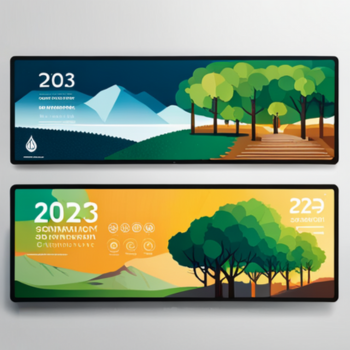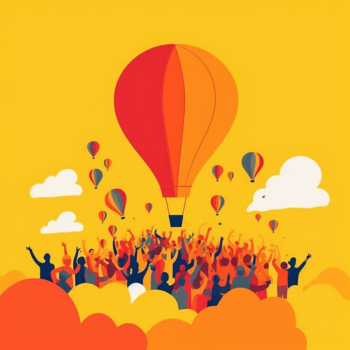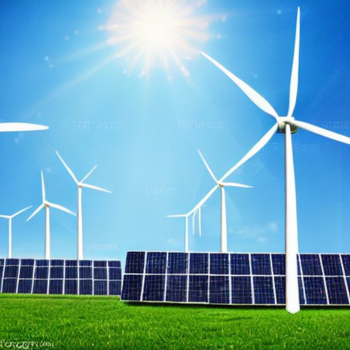A picture is worth 1,000 words. And today, it takes far fewer than 1,000 words to generate amazing graphics for your association. Traditionally, associations have relied on creatives and illustrators to generate content for things like social media graphics and ad materials. Now, through AI image generation software, organizations can take more control over these efforts and tap into an unlimited source of creativity – your own staff and members.
But what is AI image generation? How do you get workable graphics? And what tools should you be experimenting with? In our post, we’ll dive into everything associations need to know and share helpful advice to get you started!
What is AI Image Generation & How Does It Work?
AI image generation is a powerful tool for associations to create unique visuals. By leveraging the power of artificial intelligence algorithms, associations can generate realistic and highly detailed images that capture attention and elevate their message.
At its core, AI image generation involves the use of generative models trained on large datasets of existing images. The models are then used to create new images from scratch, resulting in unique and original content – without any manual effort required.
Generative Adversarial Networks
Many AI image generators work off something known as generative adversarial networks (GANs). These networks create a feedback loop between two processes – one known as the “generator,” which is tasked with creating original artwork, and the other the “discriminator,” tasked with comparing that unique output against existing data.
So, say you prompt an AI image generator to create artwork inspired by Picasso. The creator initially builds something akin to scribbles or randomly thrown colors on a canvas. The discriminator's job is to tell if the painting is a 'real' masterpiece or just a poor imitation based on its preexisting knowledge – I.e., real Picasso paintings.
The discriminator gives the creator hints on how to improve the work, and the process repeats. Eventually, you’re provided with original art based on the prompt, checked against the AI’s existing knowledge, which is deemed to be “unique and original.”
Diffusion Models
While many models are based on GANs, there are also newer innovations, such as diffusion models, which are gaining popularity. Instead of depending entirely on creating art based on preexisting inputs, diffusion models are trained on millions of images. These images (combined with text captions), help the model “understand” both descriptions, but also conceptual information.
When it’s prompted, these models create entirely unique art based on their understanding of the words you provide. “That means that if you ask them to generate an image of a dog, they won't just find an image of a dog and then add some details to it. They'll create the image of a dog from scratch, based on their understanding of what a dog is.”
Leveraging AI Image Generation: Valuable Use-Cases for Associations
For associations, AI image generators can provide a lot of value, particularly when trying to personalize experiences for members. Some of the opportunities include:
- Event Promotion: Associations often host events, conferences and meet-ups. AI image generation can help design unique and eye-catching promotional material for these events, including graphics for social media posts and art for on-site materials.
- Member Engagement: Associations can use AI image generation to personalize communication with members. For example, on special occasions like anniversaries or birthdays, AI can generate personalized images or cards for each member.
- Content Creation: AI image generation can aid in creating visually appealing content for social media, newsletters and blogs. By simply inputting text, the AI can generate relevant images, making content more engaging and reducing the need for stock photos or hiring professional photographers.
- Branding: Associations can leverage AI image generation for consistent and innovative branding. AI can generate a wide array of logos, banners and other visual branding elements in line with the association's ethos and color scheme. This helps maintain brand consistency across different platforms.
- Educational Materials: For associations involved in professional development and education, AI image generation can help create illustrative diagrams, infographics or visual aids to enhance learning. This can make complex concepts easier to understand and keep learners engaged.
- Data Visualization: AI can generate clear and compelling visual representations of data for reports or presentations, a useful tool for associations that need to communicate complex data or research findings to their members or the public.
- Virtual Tours: For associations that manage physical locations, such as museums or historical sites, AI image generation can be used to create immersive virtual tours, which can drive engagement and allow the general public to explore these locations remotely.
Benefits of Using AI Image Generation
Now that we know how associations can use AI image generation, why should they do it in the first place? Outside of gaining access to unique and creative graphics, this process can have plenty of added perks, including:
- Efficiency: By automating the image creation process, AI image generation can save considerable time and effort. You no longer have to spend hours searching for the perfect image or hiring a professional to create one.
- Creativity: AI image generation algorithms can produce a wide variety of unique and visually stunning images, all while leveraging your existing staff who may or may not have the expertise needed to create them.
- Customization: AI image generation tools allow for extensive customization. Whether it's specific colors, styles
,or themes, you can generate images that perfectly match your requirements – entirely based on your association’s existing style guide and color palette. - Scalability: AI image generation can produce many images in a short period. This is particularly beneficial for larger associations that need to generate a significant amount of visual content but can’t wait for approval or funding for a designer.
- Cost Savings: AI image creation can help associations save on the costs associated with hiring graphic designers or purchasing stock images, all while remaining consistent (a challenge when working with multiple artists and designers).
5 AI Image Apps to Experiment With
Now, it’s time for the best part of any journey into the world of artificial intelligence – experimentation! While there are plenty of different tools out there – just try searching for “AI image generator” – here are a few that work as a starting point.
- Midjourney: Requires a Discord account but allows you to create increasingly complex graphics with simple prompts. Outside of what's in the image, you can also ask it to experiment with different styles and even specific camera settings.
- DreamStudio: A web-based interface makes DreamStudio one of the easier tools to experiment with. Like others, you can use prompts for unique styles and dimensions that streamline graphic design requirements for associations.
- Stable Diffusion: Focused mainly on text-to-image creation, Stable Diffision offers a more straightforward approach. This platform does have added features like a prompt generator and prompt search to help inspire some of your work, but it requires a lot more detail to get a workable image.
- DALL·E: Created by OpenAI, the minds behind ChatGPT, DALL·E also focuses on text-to-image creation. It doesn't have pre-built prompts and styles, but as long as you know what you're looking to create (stylistically), it offers plenty of creativity.
- NightCafé: More of an artistic approach to AI image generation, NightCafé excels in creative image generation. There are built-in styles, including Hyprereal and CGI characters, which give you an easy place to start with less detailed prompting.
Sample Image Prompts
Of course, all AI image generators are different, and you’ll likely find one that fits your needs and prompting style. For example, my go-to (and the tool used to create the image for this blog) is Midjourney. However, all our suggested tools can work as a jumping-off point for your needs. And remember, there are plenty of other tools out there that can even help come up with a prompt!

In-Person Conference Graphics: "Generate a vibrant and professional conference banner for our '2023 Global Sustainability Summit'. The banner should include the title of the conference, the date (June 1-3, 2023), and our association's logo. The design should incorporate elements related to sustainability like trees, a globe, and recycling symbols. The primary colors should be green and blue, aligning with our association's commitment to environmental preservation." (Made with DreamStudio)

Fundraising Event Graphics: "Generate an emotionally engaging image for our 'Hope for Children' fundraising event. The image should depict a hopeful, positive future for children, and should resonate with our audience's desire to contribute to this cause. The primary colors should be warm and inviting, such as soft yellows and bright oranges." (Made with Midjourney)

Blog Post Graphics: "Create a visually engaging featured image for our blog post titled 'The Future of Renewable Energy'. The image should represent a positive, futuristic view of renewable energy sources like solar panels, wind turbines, and hydroelectric dams. Please use a bright, optimistic color palette to convey the promise of renewable energy." (Made with Stable Diffusion)
Boosting Creativity with AI Creation
Ultimately, leveraging the capabilities of AI image-generation tools offers associations an excellent opportunity to save both time and money without skimping on creativity. Whether you’re using it for social media graphics, building that ad campaign for your next annual conference or creating data-driven infographics, there’s likely an AI tool for it.
All it takes is understanding how it works and experimenting with some of the available tools out there. And remember, if your output looks a little wonky, try adding detail to your prompt. At a bare minimum, these tools can work as an effective starting point for your team and open the door to possibilities for your association.

May 13, 2023

